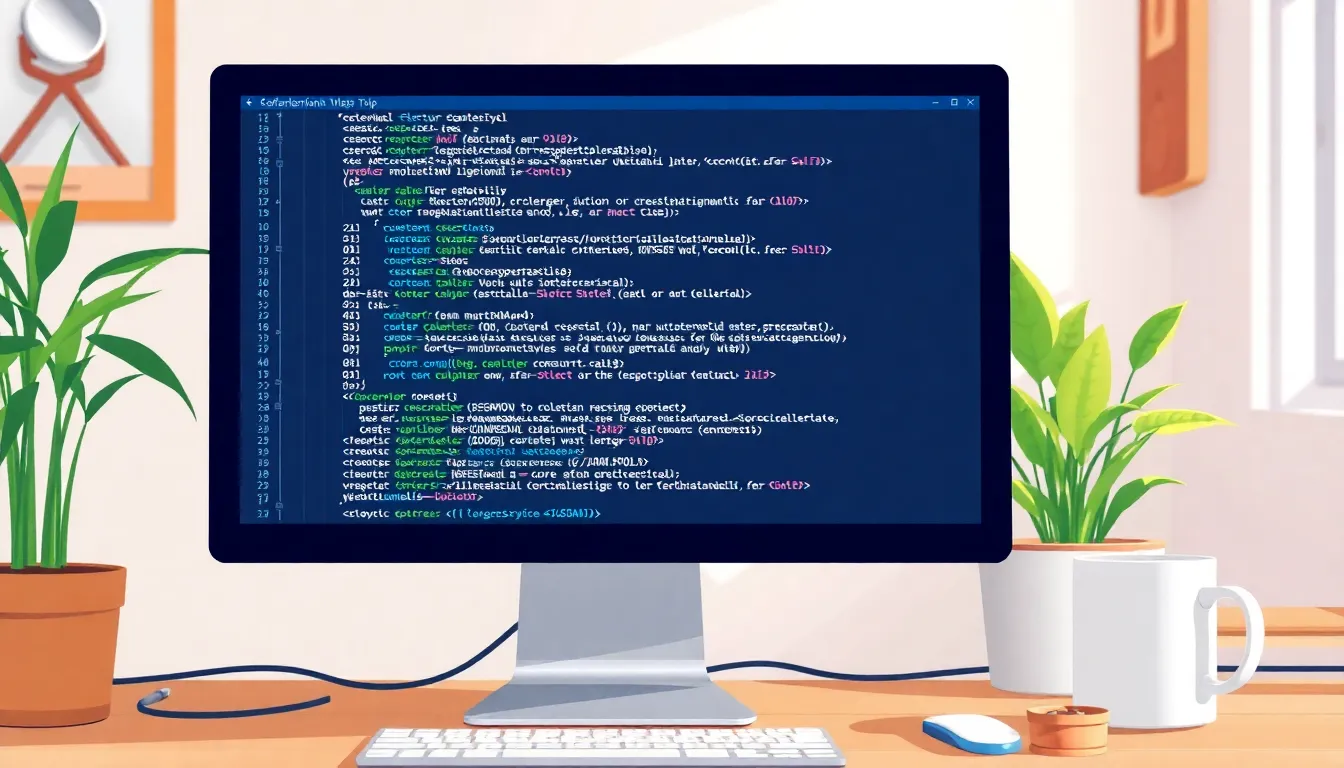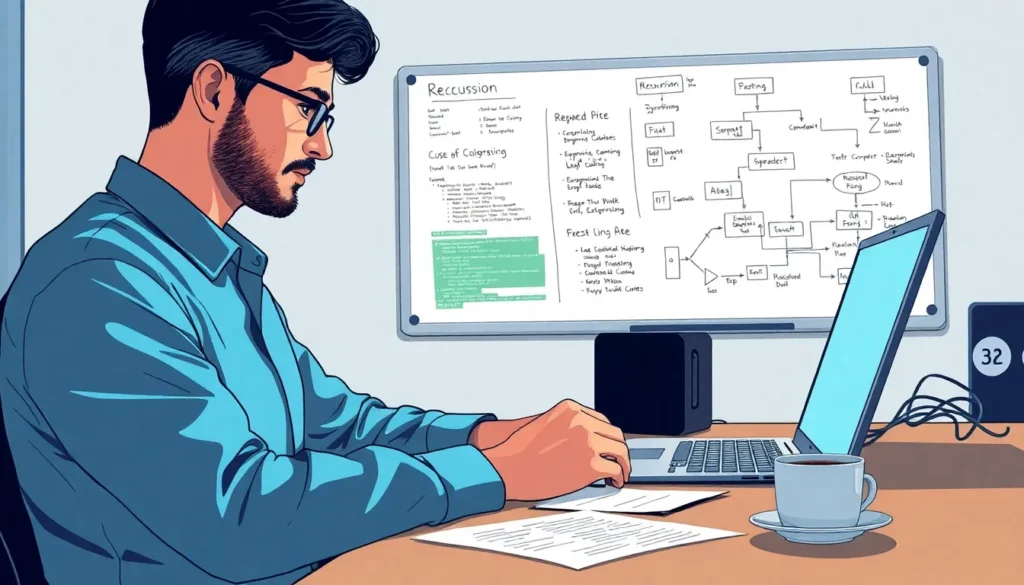Table of Contents
ToggleRecursion: the magical spell that makes programming both enchanting and perplexing. It’s like a never-ending loop of fun where a function calls itself, creating a delightful dance of code. But don’t be fooled; mastering recursion can feel like trying to unravel a ball of yarn while blindfolded. Yet, once you get the hang of it, you’ll wonder how you ever wrote code without it.
Imagine solving problems with elegance and grace, all while impressing your friends with your newfound wizardry. Whether you’re calculating factorials or navigating complex data structures, recursion can transform your coding game. So, buckle up and prepare to dive into the captivating world of programming recursion, where clarity meets creativity, and the only limit is your imagination.
Understanding Programming Recursion
Recursion occurs when a function calls itself to solve a problem. This approach breaks down complex tasks into smaller, more manageable subproblems. Solving these subproblems often leads to a straightforward solution for the overall problem.
Key characteristics define recursion. Base cases serve as stopping points for the recursive calls, preventing infinite loops. Each recursive call should make progress towards a base case, ensuring eventual completion. Without a clear base case, a recursive function might run indefinitely, causing a stack overflow.
Common applications of recursion include calculating factorials, traversing trees, and generating Fibonacci sequences. Each example showcases recursion’s efficiency and elegance. For instance, calculating a factorial, which represents the product of a positive integer and all its predecessors, demonstrates recursion’s simplicity. The factorial of 5 can be expressed as 5! = 5 × 4!. The function builds upon itself until it reaches the base case of 1.
When implementing recursion, it’s essential to consider performance. Recursion can consume significant memory because each function call adds a layer to the stack. In languages like Python, deep recursion might trigger stack overflow errors. Iterative solutions can sometimes provide better performance in such cases. However, recursive solutions tend to deliver cleaner, more intuitive code.
Lastly, mastering recursion enhances problem-solving skills. Programmers gain the ability to approach challenges creatively. Familiarity with recursive patterns fosters a deeper understanding of algorithms, leading to improved coding abilities. As developers embrace this powerful concept, they elevate their programming skills and tackle complex problems with confidence.
Types of Recursion

Recursion can be categorized into two main types: direct and indirect recursion. Each type has its own unique characteristics and applications.
Direct Recursion
Direct recursion occurs when a function calls itself. This method is straightforward and often easier to understand. One common example involves calculating factorials. In this process, the function will call itself with a reduced argument until it reaches the base case, such as zero or one. Direct recursion allows programmers to break down tasks into smaller pieces quickly. Each call creates a new layer in the call stack, showcasing recursion’s power and simplicity. However, developers should consider the potential for stack overflow when dealing with large inputs.
Indirect Recursion
Indirect recursion involves one function calling another, which eventually leads back to the original function. This cycle can be more complex yet efficient for certain problems. An example includes two functions, A and B, where function A calls function B, and Function B calls function A again. Indirect recursion allows for different processing steps within the recursive cycle, making it flexible for various algorithms. Although it can introduce confusion, careful design can leverage indirect recursion to solve intricate problems effectively. Understanding both types strengthens a programmer’s ability to implement recursion in various scenarios.
Advantages of Using Recursion
Recursion offers several significant advantages, particularly in simplifying complex problems. One notable benefit includes enhanced code readability. When structured properly, recursive solutions often present a clearer and more elegant representation of the problem at hand, making it easier for programmers to follow and understand their logic.
Another advantage lies in the reduction of code length. Recursive functions can eliminate the need for extensive loops and auxiliary variables, leading to more concise code. For instance, calculating Fibonacci numbers through recursion can result in fewer lines of code compared to iterative methods.
In addition, recursion is particularly effective in dealing with hierarchical data structures, such as trees. Recursive algorithms naturally align with the structure of trees, allowing for simple implementations of operations like traversal. Such alignment fosters seamless navigation through data.
Moreover, recursion enables the exploration of backtracking algorithms. This approach is useful in scenarios like maze solving or puzzle completion, where multiple possible paths require systematic exploration. Recursive calls can easily backtrack to previous states, facilitating effective solution finding.
Efficiency in problem-solving emerges as another advantage. Recursion often simplifies the process of dividing complex tasks into smaller, manageable ones. When a task can be broken down effectively, the solution process becomes more straightforward.
Finally, mastering recursion can enhance algorithmic thinking. It encourages programmers to think in terms of base cases and recursive cases, deepening their understanding of computer science principles. This foundational knowledge proves valuable in tackling a variety of programming challenges, equipping them with the skills to create efficient solutions.
Common Use Cases for Recursion
Recursion serves various practical purposes in programming. Its elegance simplifies complex problem-solving, making it a preferred choice in multiple scenarios.
Factorial Calculation
Calculating factorials exemplifies a classic use of recursion. A function computes the factorial of a number n by multiplying n with the factorial of n-1. This process continues until it reaches the base case, where factorial of 0 equals 1. Code for this recursive function is typically concise and expressive, illustrating the straightforward nature of recursion. For example, the factorial of 5 computes as 5 × 4 × 3 × 2 × 1. Implementing this in programming languages like Python highlights clarity while maintaining efficiency.
Fibonacci Sequence
The Fibonacci sequence is another well-known application of recursion. A function generates Fibonacci numbers through the relationship where each number in the sequence sums the two preceding numbers. Specifically, Fibonacci of n equals Fibonacci of n-1 plus Fibonacci of n-2. This recursive approach simplifies code and emphasizes the mathematical relationship. The sequence starts with 0 and 1, ensuring that Fibonacci of 0 equals 0 and Fibonacci of 1 equals 1. As a result, implementing Fibonacci recursively showcases both elegance and clarity in programming practices.
Best Practices for Programming Recursion
Prioritizing clarity in recursive functions improves readability and maintainability. Always define a simple base case early in the function to terminate the recursion. This base case prevents infinite loops and stack overflow errors, ensuring stability in the execution.
Utilizing meaningful names for functions and parameters conveys intent and enhances comprehension. Clear naming allows others to understand what each part of the code does, thus simplifying collaboration in teams.
Structuring recursive calls thoughtfully reduces complexity. Each function call should focus on a distinct subproblem, making the solution more intuitive. This approach clarifies how the larger problem breaks down into smaller components.
Optimizing performance requires awareness of the limits of recursion. Some languages, like Python, can hit recursion limits easily. Implementing tail recursion, when possible, can mitigate performance issues as it allows some compilers to optimize and use less stack space.
Testing with a variety of inputs reveals edge cases that may not handle recursion well. Programmers should conduct thorough tests for both base cases and recursive scenarios to ensure robustness.
Visualizing the recursive process aids in understanding and debugging. Diagramming how the function executes may clarify the flow of calls and returns, highlighting potential issues.
Considering iterative alternatives remains essential. While recursion offers elegant solutions, sometimes loops provide better performance and avoid stack overflow issues.
Utilizing tools like debuggers helps track the execution path of recursive functions. By stepping through the code, programmers can see the state at each stage, making it easier to identify and fix errors.
Adopting these practices enhances skills in implementing recursion effectively, allowing for cleaner, more efficient code that enhances overall programming capabilities.
Recursion stands as a powerful technique in programming that can transform the way developers approach problem-solving. By breaking down complex tasks into simpler components it not only enhances code readability but also promotes a deeper understanding of algorithms.
Mastering recursion enables programmers to tackle intricate challenges with ease and creativity. As they refine their skills they unlock the potential to write elegant solutions that can simplify even the most daunting problems. Embracing best practices ensures that recursive functions remain efficient and maintainable, paving the way for continued growth in their programming journey.




